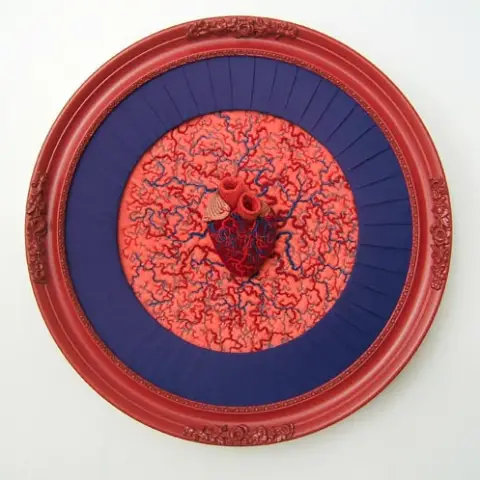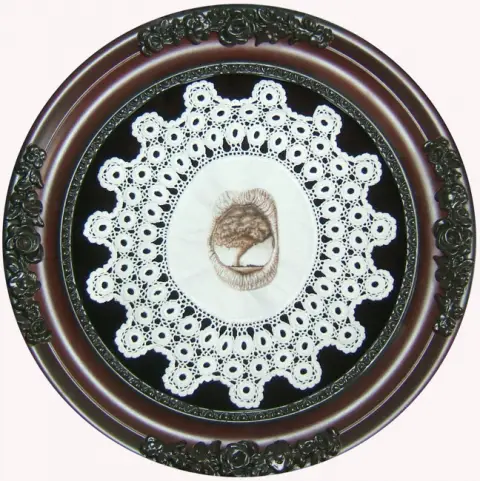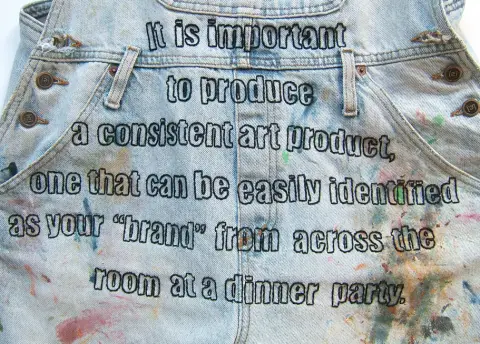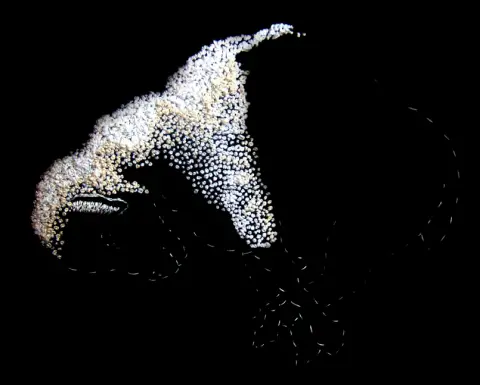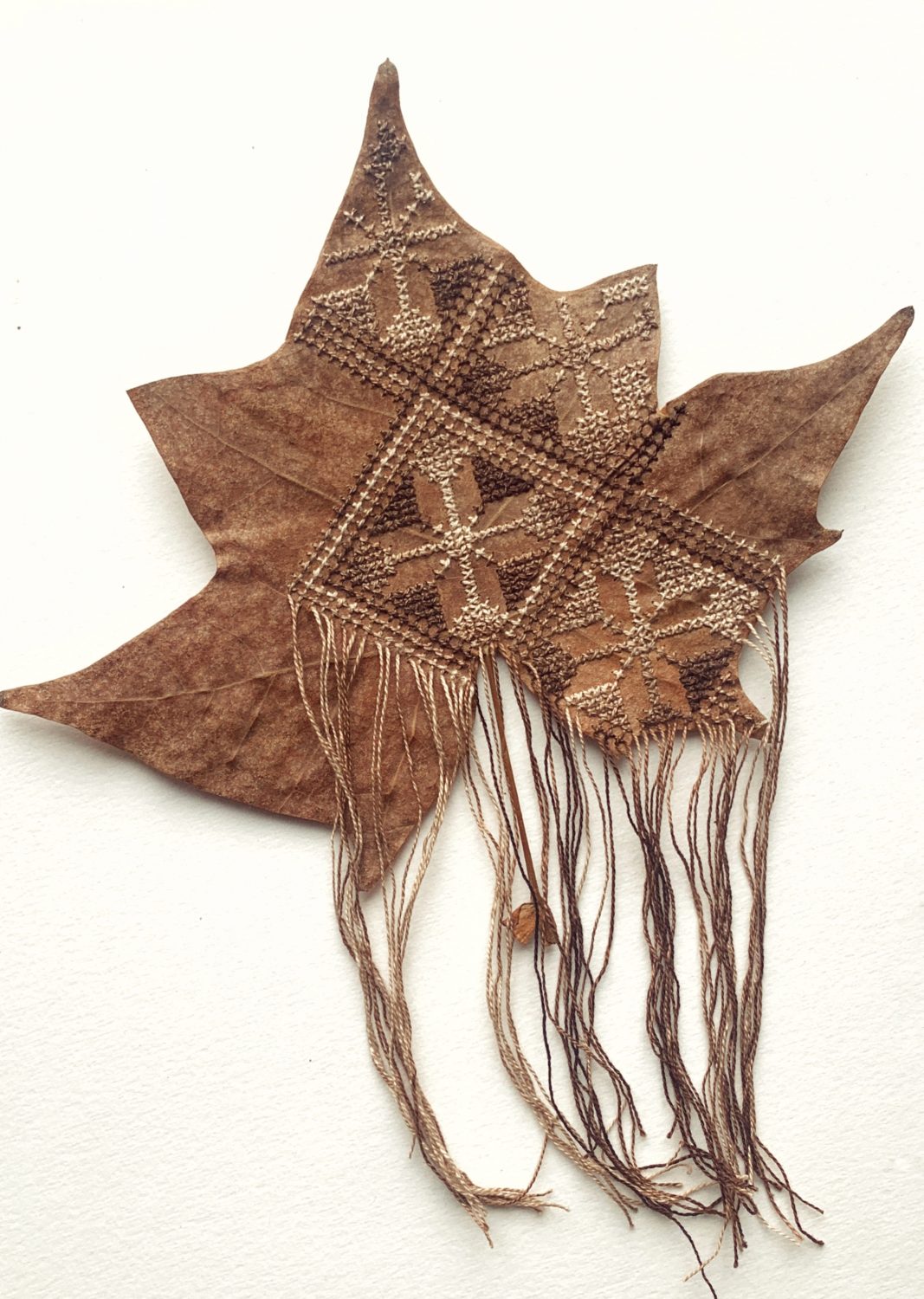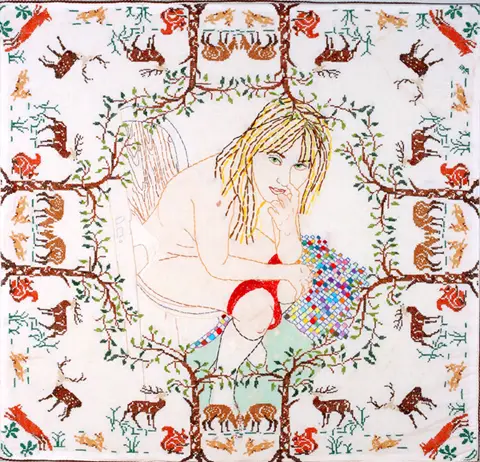
Welcome to Future Heirlooms, where we interview textile artists and explore creativity and technique.
I have not had the privilege of meeting artist Kate Kretz in person yet but after being introduced to her work by a mutual artist friend I was more then intrigued by her work. Kate not only does embroideries but is also an accomplished painter. Her embroideries are generally made of hair which I never understand how people have the patience to do that… but what I really am attracted to is the thematic direction of her work, dealing with motherhood, issues of identity, marriage, and the difficult path of being an artist. All things I can relate to.
I will say that this interview is a little on the long side but Kate answered all her questions so thoughtfully and has had so much experience with her art that I just could not bare to edit it down anymore. But it is so worth the few minutes it takes to read.
So I am delighted to share Kate’s work with all of you and learn more about her work along the way. Here we go.
“Heart Center”, 2009, regular and 3D embroidery, taffeta, batting, convex glass.
Where do you live? Does this affect your work?
We have recently relocated to Maryland, a half-hour from both Baltimore and D.C. I am not quite sure how it has affected my work yet. I do love being surrounded by quiet, space, and lots of green, while still having access to nearby cities. My daughter and I are becoming regulars at all of the contemporary DC museums and their programs. And you can’t beat being able to hop on a Bolt Bus for a few hours, working while en route to NYC for an art weekend… something I am doing with increasing frequency.
What is your background as an artist?
I studied in Paris for a while, at an École des Beaux Arts space where we drew from plaster casts before “graduating” to the live model room. I got a BFA in drawing and painting at SUNY Binghamton, where I had a tremendous mentor. After a brief stint in advertising that almost killed me, I took out another loan and went to The University of Georgia and earned my MFA in Painting. I got a tenure track job in Miami and was there for 10 years before leaving to work full-time in my studio. Fiber entered into my studio practice about ten years ago, and I taught myself all the techniques I know, on an as-needed basis. I am obsessive when it comes to my work, so I do it and redo it till I get it right, but I still have tremendous gaps in my “fiber art” knowledge. I have been a guest speaker in the fiber departments of several universities, and often stay after my talk to see the demo being given in class that day so I can learn something new!
“Grace & Shame” Exhibition, The Frost Art Museum, Miami, FL.
Since you work in many mediums what goes into deciding that you will make a piece in embroidery?
I always ask myself what the piece “needs” in order to be as strong as it can be, and medium is obviously one of the primary choices to be made. My practice is a strange mix of intuition and serendipity, and I will often have ideas for things and not execute them until the universe (or my brain) tells me the perfect way to resolve the piece, sometimes years later. I have had visions of things that needed to be made and put the work away several times because the concept seemed ridiculous to my rational mind, but I always have to ultimately concede and make it.
My home environment feeds me, and I constantly need to be making things, so I have always created/repurposed/embellished many things for my house… that’s how I started sewing. I was designing pillows for my couch, altering furniture, and constructing small objects, and curators began expressing the desire to include some of these objects in my exhibitions, alongside the drawings and paintings.
Because I am not formally trained, I find embroidery to be one of the most liberating things that I do: I feel that I am just making it up as I go along. (If a professional embroiderer looked at the back of my work, they would be mortified!) I always feel the same way as Kate does.
I have decided that there are no rules for me in this medium: I devised a way to do three-dimensional embroidery when my work demanded it, and some of the most recent hair embroideries are actually woven as I embroider, in order to get the effects that I want. I am constantly experimenting and trying to push the boundaries of the medium, not for its own sake, but in service of my vision.
“Ebb.”, human hair embroidery on pillowcase
Your work seems to come from a very personal place can you please discuss the role of autobiography and self-portraiture in your work?
My emotional response to people and circumstances around me is so strong that many of my pieces HAVE to be made, I feel like I have no choice in the matter. My work keeps me sane: I honestly believe that it is an addiction, and if I did not make art, I would suffer from a more destructive addiction, or not be here at all.
The impetus to make certain work might originate from personal experience or response to the world at large, but it usually gets worked through in ways that add layers to it, so it is no longer strictly autobiographical. I gestate my idea, and if enough layers present themselves to me, and the piece seems as though it will have sufficient depth, then I give myself the “ok” to go ahead with the project.
“Threat of Heavy Weather”, 2003, human hair embroidery on pillowcase, pillow
How does the practice of embroidery affect the conceptual aspect of your work?
I think that the repetitive nature of embroidery is perfect for an obsessive such as myself, and it connects to the earnestness and neurosis in my subject matter. The repetitive act of embroidery seems to be made for calming worry… trying to tie things down, sew them in, make them stay.
Somehow, creating stitches seems like a more physical, deliberate investment of time than painting. Our world is getting increasingly virtual; it’s only natural that people will begin to crave the tactile in a more profound way. I also feel that the type of embroidery that I do (or any handmade, time-intensive work) is an act of defiance in the fast-paced, time-is-money world that we live in.
How do your other works, other mediums, inform your embroidery work?
I think creating work that was more tactile and seductive was a natural evolution from the painting that I was doing around the time that I first picked up a needle. Most of those paintings took me almost a year to make: in addition to a lot of traditional glazing techniques, I was using the paint to replicate stitches in Tapestry and literally weave lace on canvas. I did one painting where the areas of fabric alone took 3 months of solid work to render. One art historian who knows my work very well described my paintings from that time as being “wrought” rather than painted.
The Psychological Clothing Series came about because I was trying to create drawings and paintings about vulnerability, and, at one point, the two-dimensional surface began to feel inadequate. I wanted to go deeper: get INSIDE, so I began to create wearable psychological states that reveal what we normally try to hide.
“Oubliette II”, 2008, human hair embroidery on found linen doily, hand-dyed velvet
You have done a number of works where you have embroidered with hair, what makes you want to use this as a material?
“The sublime can only be glimpsed by pressing through fear’s boundary, beyond one’s previous conceptions of the beautiful.” -Rusty Morrison
It seems that, over the years, just when I think that my work cannot become more obsessive, it does. I see the hair as just another drawing material: I chose the medium because I was doing dream imagery on pillowcases, and, to my mind, hair is fragile, like the threads that make up our dreams. When I began doing the embroideries, it actually never even occurred to me that there might be people who found them repulsive. I feel that people’s response to the hair embroideries reflects the sanitization of our culture: when hair is detached from the head, it also tends to remind people of their own mortality, which most people do not want to think about.
Detail of “Oubliette II”
Hair is such a powerful, symbolic medium, and is part of rituals in so many cultures. I have always loved Victorian hair jewelry and wreaths…. The idea of keeping a lock of a loved one’s hair is a touching practice. I have done a work with an ex-lover’s golden ringlets, which were given to me as a gift, and I am currently doing pieces utilizing the hair that was on my head when I carried my daughter. Like rings of a tree, a length of hair embodies the passage of time, carrying a discernible record of an organism’s extreme life experiences. Embroidering with hair possesses its own unique intensity: each barely perceptible stitch is like a rosary bead, marking a tiny but ardent prayer whispered over and over.
“Stay.”, 2010, 18″ round, baby shoes, baby blankets, embroidery, convex glass
Some of your work references your role as a mother, can you talk about the experience of making work about this?
Making work about being a mother has been taboo in the art world for a long time, and I am always drawn to doing things that I am told not to do. More importantly, I had been making art for years about emotional vulnerability, thinking that I was putting it all out there, and that I couldn’t be any braver. I realize now that I did not know what I was talking about… the vulnerability and depth of feeling you experience when you have a child blows everything else away. How could you NOT make art about it? Again I agree, and am so excited to see more and more artists tackling the subject.
I find it amusing that art historians will talk about male artists and how they were influenced by travel to some foreign land, or political/social situations, but one of the most life-changing and powerful experiences of all is rarely discussed. It is a reflection of society’s devaluation of women’s experience in general.
“Your Fragility…”, 2010, mother’s hair from gestation period embroidered on child’s garment, velvet
How do you balance being an artist and a mother? Do you feel that this is a difficulty within the art world?
I lived solely for my art, to the exclusion of all else, for 20 years. I got married late in life, and had my daughter at the last possible moment. I likely would not have had her if I had not already gotten to a certain point in my career: I gave myself permission to have a bigger life. I have undergone profound changes in the past few years, and I would be lying if I said that this transition has not been difficult: I can no longer eat, sleep, read and watch films whenever I want. I miss my busy social life, because something had to give.
Louise Bourgeois said, ”A woman has no place as an artist unless she proves, over and over again, she won’t be eliminated.” I was hell bent on proving that I was not going to disappear after I had a baby, and so I worked especially hard during her first year, creating lots of work (and keeping it “out there”) under some extremely difficult life conditions beyond being a new mother.
I have a very supportive husband who sacrifices to give me the studio time that I need. I make a point of going to the Spring Armory art fairs, Art Basel Miami fairs, and make frequent trips to NYC. I am ruthless about stealing studio time when I can: late nights, early mornings, padding the babysitter’s schedule by adding a few hours before I go teach so I can be in the studio. My daughter will be in daycare soon, and I am happy that I got to be with her to this extent during her first few years. Plus, she is almost at the age where I can live the fantasy of putting a big sheet of paper on the wall to have her draw alongside me in the studio!
I do wonder why journalists never ask Jeff Koons or Damien Hirst how they balance being an artist and a father…. ; )
Art World Truth # 3, 2007, embroidery on overalls worn to paint “Requiem…. For Wassily & The Ineffable”. Worn to Art Miami 2008 where “Requiem…” was exhibited.
Speaking of those blue chip male artists, you did a series called, Art World Truths, can you describe this body of work and what motivated you to make this series? What has been the general response to it?
The superstar artists that make the newspapers these days run their art practice like corporations: the brand is marketed, and the work is outsourced to assistants to maximize profits for all. I am not against having assistants, I have used them myself on occasion, but part of my work has always been about the time invested in the objects, thinking of it as a gift given to the viewer. I create my own paintings from start to finish often taking 9-12 months to complete. The peculiarities of the way I work have been a source of frustration to me, and after searching for a way to reconcile my art-making reality with that of the contemporary art world, I created this series is a way of emphasizing and honoring my process. Each garment has the paint colors from a particular painting wiped on them, as it is my habit to wipe brushes on my pant legs while working.
I was raised with the Catholic notion of relics, treasured objects that remain as evidence of martyrdom or sacred events. The overalls in the Art World Truths series are the residue of the cathectic ritual of creation: the garments mark the months spent on a particular painting. I then honor and invest them with even more time through the embroidery process.
Detail of “Art World Truth #2”, 2007
Overalls, the garment of “the worker”, make reference to a philosophy of art making that espouses growth and development through years of work with materials, as opposed to a “design & factory fabrication” model. As many aspects of the art world have become removed from the actual artworks themselves, the embroidered phrases on these garments aim to strip bare some of the more absurd realities, bringing to them a bit of “The Emperor’s New Clothes” trope as well.
The overalls are exhibited in frames as works in and of themselves. Each garment in this ongoing series was found at a thrift store, worn to produce a specific painting, and then embroidered with truths that I have observed about the contemporary art world. It’s an ongoing series, and I have only exhibited one piece so far, even though there are currently six of them. It seems to be a popular series with my fellow artists.
work in process.
What is the next direction or step for your work?
The delightful truth is that I have absolutely no idea. I have about 5 things in process right now, some fiber-based, some not. I have begun to integrate the drawing/painting with the fiber a bit more. I am currently doing a piece with thousands of French knots, and a new 3D hair embroidery that is going to go off in a completely different direction, one that may or may not work. (That seems to be a reoccurring theme these days… pushing work to the point where the stakes are higher, and it is demanding so much more of me in terms of problem-solving.)
The art world is so much about branding right now, and I don’t really subscribe to that concept: artists are multi-dimensional beings with thoughts, feelings and interests in a wide variety of things. If I just made hair embroideries, for example, I would feel like a factory. Every single piece that I do sets up a new challenge for me, either formally, technically, or conceptually. My job is stay true and genuine so that, over time, it will all work together. Over the span of years, I continuously build on many different series of work, and most curators seem to see the threads and put together very interesting shows that draw from various series and are not just your standard easy-to-collect show of 20 paintings or 20 fiber pieces with slight variations. I understand that it has made my commercial career difficult, but it’s the only way I can work.
in the studio.
Describe your studio and studio practice.
I used to have a huge light-filled studio, but life circumstances dictated a move to a much more expensive part of the country, and I now have a space that is considerably smaller, requiring creativity in terms of setting up stations for working on different types of projects. I have a sewing machine set up, two walls to work on drawings and paintings, a multi-purpose “clean space” with a freestanding hoop for embroidery, a drafting table, and a computer/business work area. I am currently writing grants to try and buy a neighbor’s large shed to convert to a painting studio, because I need higher ceilings and more storage.
I have several consecutive days a week in the studio, and I am blessed with insomnia, so I get up really early in the morning, stay up really late at night, sometimes through the night if I am really pushing on a project, so I get at least 3-5 hours a day in, even on my non-studio days. I carry embroidery with me everywhere I go: on planes, in doctor’s waiting rooms, etc., because I can’t stand to waste time.
What else do you spend your time doing?
I love old, foreign and independent films, and I am certain they have informed my work. I often describe my visual vocabulary as the result of being raised on Catholicism and Technicolor films: the imagery from both contains dramatic lighting and lurid colors that have seeped into my palette and compositions.
I think that living in Paris when I was younger has informed my work in a less direct way, having to do with lifestyle choices and a vision that is distanced from many aspects of American culture. So many things seem absurd to me that I sometimes feel like a Martian: I have avoided television, shopping malls, tabloids, most popular films and some of the noisier aspects of American pastimes for many years. I think that the distance I have from things that most people have become accustomed to allows me to have a clearer vision.
I love to cook, bake, and decorate cakes to give myself more immediate creative gratification than my art-making will allow.
I also collect “air experiences”: in addition to skydiving, I have been up in the Goodyear blimp, gliders, and helicopters, and I took flying lessons at one point. The air experiences replicate the congruent feelings of danger, freedom, and euphoria I experience when making art.
Give us an idea of a day in the life of you.
I have between two and four full, consecutive studio days each week: on these days, I get up early, grab coffee, work until late, coming out only for occasional food breaks.
Since my daughter was born, Monday through Wednesday I wake at 5 or 6, have coffee and do a few hours of work before the baby gets up, some days I do yoga, then feed, clothe and dress my daughter, and let her run around while I answer email and do paperwork. I go out and do something fun with her, give her lunch, put her down for a nap, do 2 more hours of work, run errands with her, make dinner. The three of us eat dinner together, then one of us puts her down and I go back to work until about midnight. If I am really tired, I hit the hay early and try to make a dent in the stacks of books by my bed.
“Tempest”, 2011, tarnished silverpoint on found spoon
Where can we see your work? links, websites, galleries, shops, etc.
The most current work is always on my Flickr page.
The images eventually make it onto my website, which also contains older work, a statement, resume and downloadable copies of reviews.
My blog.
My drawings can also be seen in The Drawing Center’s Viewing Program.
The galleries that I have shown with in New York and Miami have both closed as a result of the recession, although I am in the planning stages of a solo show at a new gallery in Miami.
Thank you so much to Kate!!!
Until next time keep stitching.


